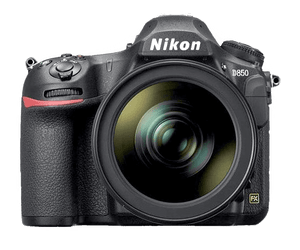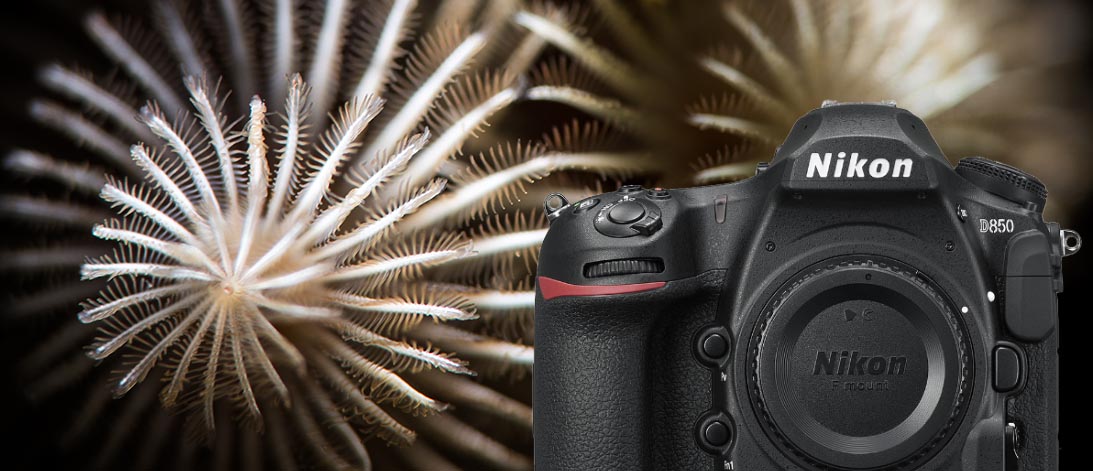Nikon D850 Review
September 7th, 2017
Nikon D850 Camera Review
Nikon continues to innovate with their flagship dSLR cameras, and the D850 is no exception. Previously photographers had to choose between the speed and video capabilities of the D500 and the sensor size of the D810. That gap still exists although it is closer than before. Let's look at some of the key features of the Nikon D850 for underwater photography and video.
Why We Love It
The Nikon D850 is our top pick for an underwater photographer focusing on still photography or shooting hybrid stills/video. It has ultra-high resolution, top of class dynamic range, very fast auto-focus & response time, relatively low noise at higher ISOs, great color and great lens selection. 4K video is very solid. At the moment, the Nikon D850 is the king of the hill.
Shop all Nikon D850 Housing Options
The Bottom LIne:
Choose the NIkon D850 if you want the best underwater photo solution, and are willing to pay a slight premium for it, and don't mind using a larger setup underwater. No other camera can touch its auto-focus capabilities and overall feature set. However, if you want a smaller setup you may want to look at a mirrorless camera like the Sony A7r III. Serious videographers will want to consider cameras like the GH5, A7s II, or Canon 1dX II. If you feel like you don't need a full-frame solution and want to save some money, the Nikon D500 delivers most of what the D850 does.
Key Specs:
- 45.7 megapixel, backside illuminated full-frame sensor
- 7 frames per second and a 51 shot buffer
- ISO 64-25600 (expandable to 32-102,400)
- 4K UHD video 3840 x 2160 at 30/25/24p
- Rugged body with weather and dust sealing
- 153 AF points, 99 cross-type sensors
- Great dynamic range and ISO Performance
- Great battery life
- Up to 1840 stills or 70 minutes of video per charge
- Dual XQD/SD card slots
- Bluetooth
NIkon D850 Features
Increase in Megapixels
The D850 expands the pixels on the new backlit CMOS sensor from 36.3 to 45.7 megapixels. This corresponds to the 12% increase in the horizontal pixel width. The higher resolution is welcome, although only people who are shooting very close subjects underwater with the best lenses at the optimal apertures will notice the difference. The image dimensions change from 7360x4912 pixels on the D810, to 8256x5504. Ultimately you need to decide if you really need additional megapixels – not everyone does. In DX mode, the sensor will crop down nicely to 20 megapixels, perfect for using the Tokina 10-17mm fisheye lens, or for greater reach with long/macro lenses. Of course you can always crop in post, but some photographers may prefer to compose in camera at the final resolution.'
Addition of 4K Video, MP4 file format, 8-bit color depth
The Nikon D850 is capable of 4K video using the full width of the sensor at 30p, and 1080p slow-motion video at 120fps, at a bit-rate of over 140 Mbps. This is a very high bit-rate, comparable to the GH5 and 5D Mark IV bit rates, although the 5D does have a 500 Mpbs bit rate option for its 4K video. On the downside, it does not do 60p in 4K mode like the GH5 or the 1DX II can do.
Using the full sensor for 4K video is significant, as most cameras implement 4K video in a crop mode, which means you don't get the full angle of view from your lenses. The nikon D850 does offer a 1.5x crop mode in 4K, which makes a lens like the 8-15mm fisheye a versatile lens forunderwater video.
Focus peaking in 1080p mode, zebra stripes, and a flat picture profile are also offered.
The color space of the D850 is 4:2:0, which means the color is stored with a bit depth of 8 bits. Other cameras have a color space of 4:2:2, which is a bit depth of 10 bits, which is 4 times the number of possible color levels.
Increased shooting speed & buffer size
The raw file frame rate of the D850 increased from 5 to 7 fps over the Nikon D810, a significant increase due to the new EXCEED 5 processing engine. While still not as fast as the lighting speed of the D500, it is a noticeable difference and will be appreciated when shooting blink of the eye events such as animal behavior. The shooting speed increases to 9fps with the optional battery grip.
The RAW buffer size for 14-bit lossless compressed files has been almost doubled to 51, which should be sufficient for almost any shooting scenario. For 12-bit raw files, it is an astounding 127 images. You will want to use high speed XQD cards and high speed SD cards to be able to handle the large files of the camera.
Larger Viewfinder
The built-in viewfinder magnification is 7% larger than the D810, rated at 0.75 instead of 0.7, which is a welcome change, although we still recommend the external viewfinder with an underwater housing for an even larger view.
New Autofocus System
The D850 has inherited the 153 point auto-focus system of the Nikon D5, which means it has a dedicated auto-focus engine and significantly more auto-focus points than the D810. The autofocus is without question superior to the D810 and is at least on par with, if not better than, the D500.
Boasting -4 EV range instead of -2 EV range, the camera's autofocus works far better in low light conditions than its predecessor. The central auto-focus point is rated to -4 EV (4 stops darker than a “normal” light benchmark), and the remaining auto-focus points at -3 EV.
The 3D tracking mode is fantastic, especially for locking onto macro subjects and following them around the frame. Along with the addition of the new Dynamic Group 9 AF mode (which activates a group of 9 AF points around a central one), there is an autofocus mode for every single situation.
If you are upgrading from an older Nikon like the D90 or the D300, the new autofocus system will truly seem magical.
Native ISO boost
The native ISO range of the D850 is now 25,600 ISO, an increase of the 12,800 ISO of the D810. The D850 uses a new back-lit sensor which offers better low-light performance.
On the low end, ISO 64 is a welcome option for shooting in bright conditions, which is also available with the Nikon D810 but not the D800. ISO 64 is gorgeous and the detail, color, and dynamic range at that ISO allow for better image quality than any other system underwater.
Shooting 25,600 and up is ridiculous and there is really no need to do that underwater, nor should you. The image quality will not be great, as it will be on any camera. The D850 does improve on the high ISO performance from the D810, which is impressive considering the bump in resolution. While the dynamic range does suffer as it does on any system, it is still quite nice. The shot below was made shooting at ISO 2500 in near darkness and the noise isn't offensive and details were still able to be pulled from the shadows.
If you don't need the full 45 megapixels, you can still shoot at a very high ISO and get very usable images, and the Nikon D850 will resolve this better than any other camera.
Focus Peaking, LCD resolution increase and more
The D850 adds many additional improvements and upgrades that will be appreciated by hobbyists and professionals alike, including silient Photography Mode in live view XQD card slot instead of CF card slot, Wifi & Bluetooth support, 50% greater battery life, double the LCD resolution, focus stacking, focus peaking for both stills and video, and active D-lighting for video.
Focus peaking and the increase in LCD resolution (now 2.3 million dots) will both be appreciated by underwater macro photographers, who will be able to more easily verify focus of subjects, and check detail, sharpness and clarity in the LCD screen.
Focus Stacking
Focus stacking is an exciting new feature offered by the D850. It will automatically take up to 300 shots at different focal points, and the photos can then be combined outside of the camera into one photo where the complete subject is in focus - very useful for macro / supermacro photography.This likely wouldn't be applicable in 99% of situations underwater.
There is also the ability to downsize RAW files in-camera to 11 or 25 megapixels. IMHO this is a very useful feature that will preserve the flexibility of RAW files and decrease the space and processing needs, when they are not needed.
What's Missing in the D850?
The is no longer a pop-up flash, and no GPS. The lack of a pop-up flash takes away a safe “backup” solution for underwater shooting with strobes and fiber optic cables, in case your sync cords flood or your flash trigger stops working, both of which are common in the field problems. The serious underwater photographer will have to carefully plan for contingencies now that this backup is not available. However, by removing the flash Nikon was able to improve the weather-resistant capability of the camera. Several housing manufacturers offer built in or optional electro-optical converters to work around the lack of a flash 'issue'.
There is no log gamma option for videographers, which some filmmakers have used for better tonal reproduction. However, there is a “flat” picture profile that can be used for increased dynamic range.

Best Lenses for Underwater with the Nikon D850





Nauticam Supermacro Converter - recommended for use with the 105mm VR lens. Very sharp and gives you significant magnification. A float ring and focus light will be necessary, and a viewfinder is highly recommended.

NIkon D850 Vs. The Competition
|
|
Nikon D850 |
NIkon D810 |
Nikon D500 |
Canon 5D Mark IV |
|
Price |
$3,297 |
$2,797 |
$1,797 |
$2,799 |
|
Max Resolution |
8256 x 5504 |
7360 x 4312 |
5568 x 3712 |
6720 x 4480 |
|
Effective Pixels |
45 MP |
36 MP |
21 MP |
30 MP |
| Sensor Size |
Full Frame (35.9 x 23.9 mm) |
Full Frame (35.9 x 23.9 mm) |
APS-C (23.5 x 15.7mm) |
Full Frame (36 x 24mm) |
|
ISO |
Auto, 64-25600 (Expands to 32-102400) |
Auto, 64-12800 (Expands to 80 - 25600) |
Auto, 100-51200 (Expands to 50-102400) |
Auto, 100-32000 (Expands to 50-102400) |
|
Custom White Balance |
Yes (6 slots) |
Yes (6 slots) |
Yes (5 Slots) |
Yes |
|
Image Stabilization |
No |
No |
No |
No |
|
Auto-focus |
Contrast Detect, 151 pts |
Contrast Detection, 51 pts |
Contrast Detection, 153 pts |
Contrast Detection, 61 pts |
|
Flash Sync Speed |
1/250th |
1/250th |
1/250th |
1/200th |
|
Burst Shooting |
7 fps |
5 fps |
10 fps |
7 fps |
|
Video Formats |
MPEG-4 |
MPEG-4, H.264 |
MPEG-4, H.264 |
MPEG-4, Motion JPEG |
|
Max Video Resolution |
4K (30p) | HD (60p) | 4K (30p) | 4K (30p) |

Soft and hard coral wide-angle scene taken in Fiji. F11, 1/320th, ISO 400
Sample Underwater Macro Images
In early February we took the Nikon D850 out for a spin with a Nauticam housing, a Nikon 105mm VR macro lens, a Nauticam SMC diopter, and two Sea & Sea YS-D1 strobes while diving at Santa Cruz Island - California's macro paradise. Although full-frame DSLRs are notoriously difficult to take macro photos with, the D850 nevertheless shines bright. In fact, it makes taking macro photos feel easy!
The auto focus is unbelievably fast. It surpasses any mirrorless and compact camera and most DSLR's on the market. Many images could be refocused within a couple of seconds. I found that the auto focus 3D tracking mode worked very well and was my preferred AF mode when taking macro photos. Most of the images were very sharp - even when the camera moved quite a bit, the focal points were tracked nicely. It works best with a high contract background.
At 45.7 megapixels, the resolution is more than enough for any photographer. In fact, it's unbelievable. Some of my RAW files are close to 90 megabytes! So keep in mind that extra storage is likely necessary for any serious photographer. The largest benefit of this type of resolution is for macro and super macro photographers who wish to crop their images for better composition or artistic effect. Most crops will still render a high quality photo. Check out the 100% crops below...
One thing to note - the macro set up is very heavy - floats are must in order not to get tired of holding the camera after one dive!

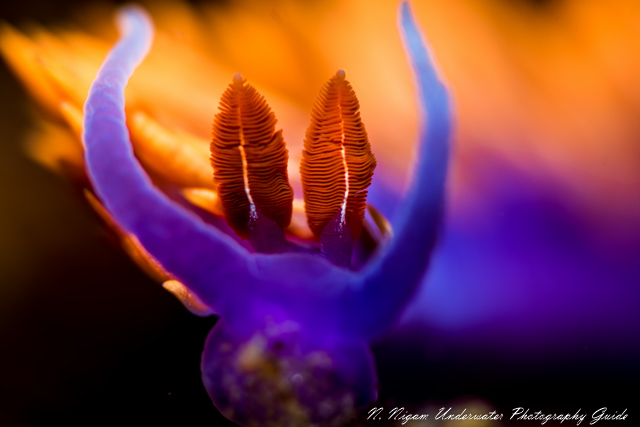
Sample Underwater Wide Angle Images
The Nikon D850 also shines when it comes to the other end of the spectrum. With class leading dynamic range, top of the line color reproduction, and 46 megapixels of detailed goodness, the D850 may well be the best camera available for wide angle shooting. We have not had the chance to get the 850 in the water in all conditions but we have had it out a few times here in Southern California, and it is hard not to be impressed with the wide angle performance. The D810 was fantastic all around camera and the 850 just moves on from it. Take advantage of the huge resolution! If you compose your images well, you can produce huge prints of the highest quality without having to crop. If you can get away shooting at ISO 64, do it. No other camera (that can be taken underwater) can match the D850 image quality at ISO 64.
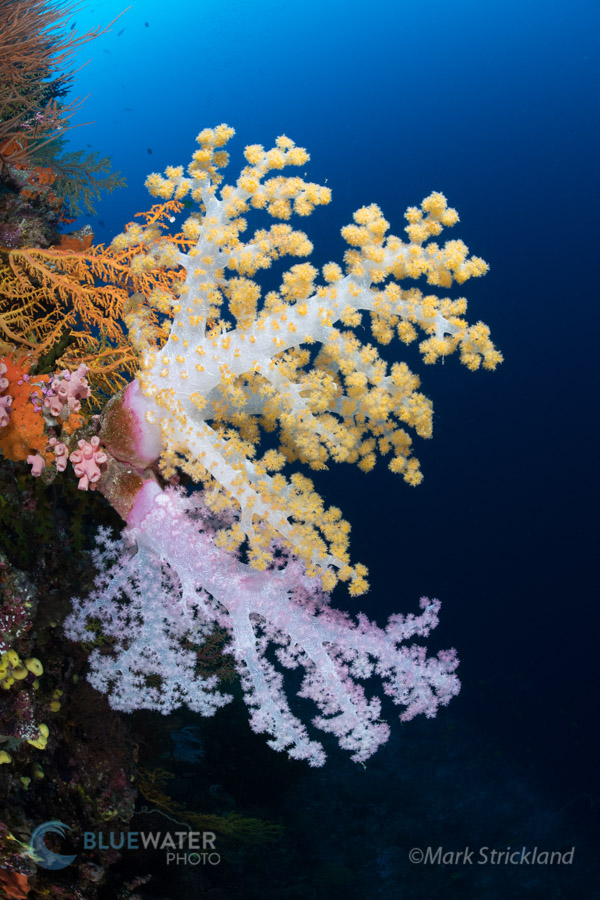
Nikon D850 Underwater Housings
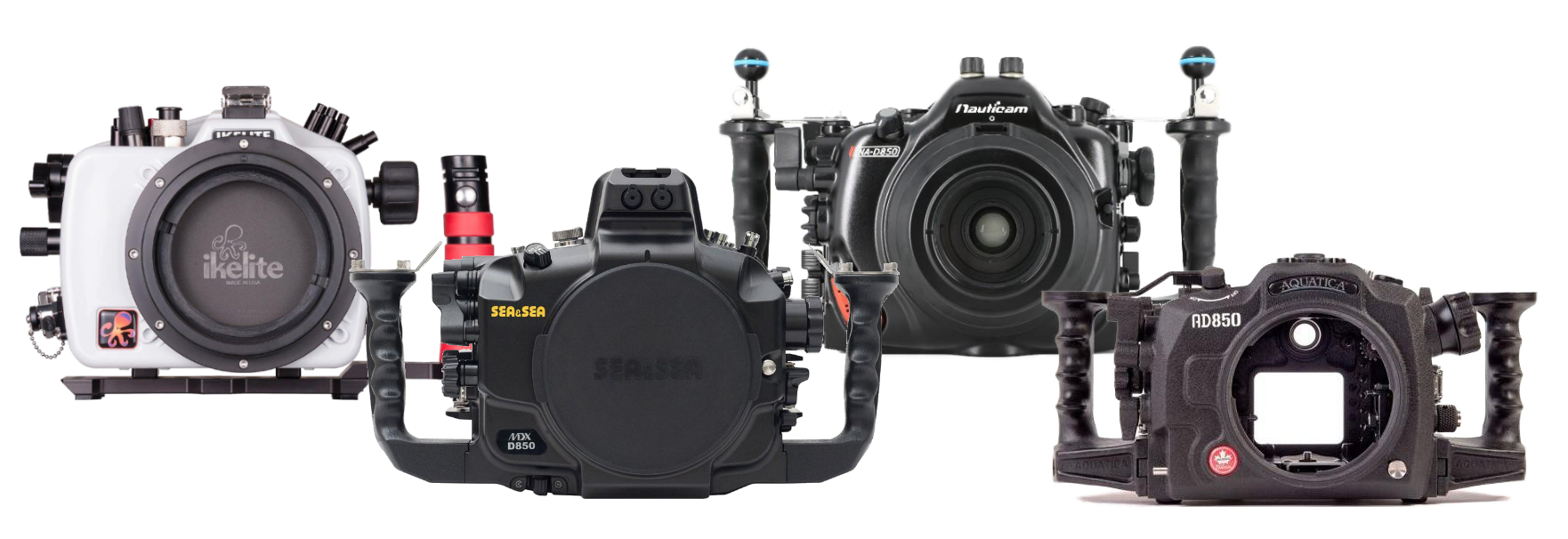
Nauticam
Nauticam is known for producing functional, ergonomic, customizable, and durable housings. The new Nauticam D850 is no exception. All the levers, buttons, and wheels on the aluminum housing are clearly labeled so there is no guessing as to what button you are pushing or wheel you are spinning.
The NA-D850 features the patented Nauticam bayonet port lock mechanism and the electro-optical converter like the one found on the D500 and the D5 housings. This allows the use of fiber optic cables on a camera that doesn't have a pop up flash. There is also a new lever that falls under the left middle finger that makes toggling between the autofocus modes very quick and easy.
Of course, the housing also provides access to all important camera functions that one would need to use while underwater. Users of other Nauticam housings will feel right at home as the ergonomics are very much the same. The housing handles faultlessly in the water (as it should) and is built to last and perform in any conditions.
Sea & Sea
The Sea & Sea Nikon D850 Housing is the smallest aluminum housing, with easy to reach controls, bulkheads for sync cords, and an optional vacuum check system and internal TTL converter. It is 11% lighter than the Sea & Sea D810 housing, which was already a very light housing. One of our favorite features of the housing is that all of the controls now have a spring to prevent slip of the controls, even if they wear over time or if the camera dimensions vary slightly. Lenses can be changed without taking the camera out of the housing.
Aquatica
Aquatica has recently announced their housing for the new flagship camera from Nikon, the D850. They have truly taken steps in the right direction with this model. The housing itself is 12% lighter than the previous D800 and D810 models, but continues to boasts the same depth rating and ergonomic controls.
One of the highlights would be the new “self-aligning controls”, which makes the already seamless task of installing the camera into the housing seem more natural and straightforward. The new self-aligning system allows the camera to slide in and out of the housing with ease, no need for pulling levers or setting controls, so there is one less task necessary before getting in the water! As with the previous models this housing is compatible with both Aquatica or Vivid vacuum check systems. Overall the new Aquatica D850 housing is the perfect example of a rugged, durable, well built system combined with the refined controls, ergonomics and innovation necessary for any underwater photographer.
Ikelite
Several excellent housings are now available for the D850, but most will cost you more than the price of the camera, even without a port. Thankfully for those on a budget, longtime U.S. housing manufacturer Ikelite now offers a very affordable alternative that still offers high quality and supports a wide range of lenses and accessories. And, it boasts their new, much improved “dry lock” port system, making it easier than ever to change ports, along with a new vacuum check system, both of which are designed to protect your delicate camera like never before
Nikon D850 Settings for Underwater
These settings are simply suggested as a starting point.
General Settings
- Shoot in Raw + JPEG
- Manual Mode
- E1 - Set max sync speed to 1/320th (high speed sync)
- A11 - focus point wrap around ON
- Drive mode can be S or CL
- We use AF-C focus mode instead of AF-S
Macro
- F16, 1/250th, ISO 200
- Adjust aperture to control depth of field
- Single spot focus
Fish
- F8, 1/125th, ISO 200
- Single spot focus
- Point strobes out to reduce backscatter
Wide-angle
- F8, 1/125th, ISO 250
- Set focusing mode to "Auto" (grid of focus points)
- Stop down to small apertures and use 1/250th when shooting into the sun
Final Thoughts
The Nikon D850 is worthy successor to the D810, and appeals to a wide-range of photographers looking for the lastest upgrade. Sport, landscape, underwater, wildlife, and macro photographers will all find something to like about the camera's new features.
The Nikon D850 won't make you a better photographer (no camera can do that) but it gives you the ability to create images of the absolute highest quality.
From Bluewater Photo's Scott Gietler - "The Nikon D850 gives you great colors, excellent dynamic range, the best auto-focus on the market, and incredible cropping capabilities when shooting macro. Whether you are shooting fast moving sharks or doing a blackwater dive, the autofocus will not let you down. Using this full-frame masterpiece is almost like cheating"
From Bluewater Photo's Matt Sullivan - "As seemingly more and more people are moving to the mirrorless cameras, the all too familiar "DSLR's are dead" shouts are more and more prevalent everyday. Enter the Nikon D850 - a camera that proves that DSLR's are very, very far from dead. For most underwater shooters, the D850 may well be the best DSLR ever made. In the past there has always been a compromise between speed and high resolution. No more. The D5 autofocus system + 7fps will be more than enough for just about every situation underwater. The dynamic range and ISO performance will be hugely appealing to wide angle shooters and the resolution to allow insane detail and ability to crop heavily will appeal to macro shooters."

Hard to beat ISO 64 on the D850! Shadows and highlights contain huge amounts of detail and are able to be pulled back without degrading image quality. I couldve pulled more out of the shadows on this image without a problem.

